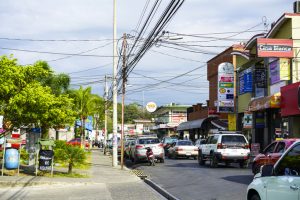By Juan Rodriguez
CONGESTION IS A PROBLEM that routinely plagues cities worldwide. The threats it poses  to society are immense: chronic pollution, crumbling infrastructures, and low quality of life. As major cities search for solutions, they often turn to tactics such as congestion pricing and curbside management—programs that can produce positive results but only treat symptoms of the problem. To cure congestion at the source, cities need to turn to dynamic mobility ecosystem hubs that manage their sources by connecting people with alternate solutions.
to society are immense: chronic pollution, crumbling infrastructures, and low quality of life. As major cities search for solutions, they often turn to tactics such as congestion pricing and curbside management—programs that can produce positive results but only treat symptoms of the problem. To cure congestion at the source, cities need to turn to dynamic mobility ecosystem hubs that manage their sources by connecting people with alternate solutions.
Congestion Control through Pricing
London, England, is one of the world’s pioneers in using congestion pricing, which requires motorists to pay fees to drive into the center of the city during busy periods. London implemented congestion pricing in 2002 with the goals of reducing traffic volumes, improving bus services, and making the delivery of goods and services more efficient. And it has worked.
In 2006, Transport for London (TfL), the government agency responsible for the city’s transportation system, found that the surcharge reduced traffic by 15 percent and congestion—which it defines as the extra time a trip would take because of traffic—by 30 percent. The TfL reports these trends continue today, with traffic volumes down nearly 25 percent compared to a decade ago. That has enabled it to open more dedicated road space for bicyclists and pedestrians.
However, congestion remains a problem due to a number of factors, including one city officials could not have anticipated back in 2002: the influx of transportation network company (TNC) drivers using their cars to work for companies such as Uber and Lyft.
The Conversation news site reports that while the number of cars driven by their owners has fallen, the number of private for-hire vehicles such as TNCs and minicabs is up. Trips by taxis and private for-hire vehicles as the main mode of transportation have increased by nearly 30 percent since the surcharge was implemented. Today, more than 18,000 different private for-hire vehicles enter the congestion charging zone each day, reducing the speed of traffic through the city.
The ripple effects include traffic jams, slower bus service, and falling revenue. Taxis and minicabs (but not TNC vehicles) are exempt from paying the congestion charge, so, not surprisingly, the number of minicab registrations rose quickly—from 49,854 in 2013 to 87,409 in 2017. Last year, TfL experienced its first drop in congestion charge income since 2010.
New York lawmakers are evaluating the pros and cons of the London case study as they prepare to make New York City the first U.S. city to implement congestion pricing. Assuming its scheduled December 2020 rollout is not delayed, motorists will pay a toll of around $12 to drive between midtown and lower Manhattan.
The plan passed as part of the state budget earlier this year, but some lawmakers, business owners, community activists, and residents are pushing for a number of exemptions. They see the mandatory surcharge as being akin to a regressive tax that imposes an unfair financial burden on the lower and middle classes, who typically don’t live in the city and have no choice but to make the daily commute.
The plan currently exempts “congestion zone” residents who earn less than $60,000 a year, as well as emergency vehicles and vehicles carrying people with disabilities. Other proposals want to extend exemptions to all New York residents, any police officers who drive their personal vehicles into the city, and all electric vehicles.
Whatever the final version of the plan looks like when (or if) it is implemented, the fight for exemptions will continue, the reduction of traffic congestion will be minimal, and the city will face the same issues of lost government revenue London is dealing with now.
A recent Quinnipiac University poll found New Yorkers oppose the congestion pricing plan by a 54 to 41 percent margin. If a majority of New Yorkers are unhappy with the prospect of having to pay extra money to drive their cars, just imagine how they might react to a policy that prohibits them from driving their cars at all.
No-drive Days
That’s the model Mexico City officials created when they implemented a “No Drive Day” program. Each weekday is reserved only for cars with specific license plate numbers and letters. The written policy states:
- Monday: no driving if license plate ends with 5 or 6.
- Tuesday: no driving if license plate ends with 7 or 8.
- Wednesday: no driving if license plate ends with 3 or 4.
- Thursday: no driving if license plate ends with 1 or 2.
- Friday: no driving if license plate ends with 9, 0, or a letter.
Of course, there are exemptions and exceptions to these rules, particularly for foreigners and Mexican residents who live outside Mexico City. Take this example of a vehicle with Texas license plates that end with the digit 3:
“Thus under the rules above from Monday to Friday, they cannot drive between 5 a.m. to 11 a.m. However, on Wednesday, they have the additional restriction that they cannot drive between 5 a.m. to 10 p.m. The only way they can get around this is to obtain a 0 or 00 sticker should their vehicle be eight years old or newer.”
Americans generally hate having to keep track of what side of the street they must park their cars on depending on what day it is. It’s safe to assume that a proposal for a No-drive Day policy will be met with vehement opposition. However, many are experimenting with restricting parking curbside.
Take It to Curb
Take a moment to think about all the uses for those lips of concrete that separate streets and sidewalks. Drivers looking for parking spots (and struggling to parallel park) fight for limited space with taxis, TNCs, and buses dropping off and picking up passengers, as well as delivery vehicles. The results are frustrating traffic jams and an increased risk of accidents involving vehicles and pedestrians.
Autonomous vehicle manufacturers and tech companies such as Google and Uber are developing solutions to ease that congestion and reduce the risk of accidents. Their intelligent route navigation and collision avoidance capabilities will enable much more efficient interactions with other vehicles to reduce the instances of unnecessary starting and stopping and prevent accidents. Still, they won’t solve the congestion caused by stopping curbside to collect or drop off passengers.
Implementing a policy that prohibits vehicles from stopping or parking curbside would be counterproductive and costly. Curbs are one of the most valuable assets a city owns (see the May issue of The Parking Professional for more). Governing magazine reports America’s 25 biggest cities collect about $5 billion in car-related revenue. The trouble is even if you widen streets; add new lanes for vehicles, bicycles, and pedestrians; or create dedicated parking zones for passenger or delivery vehicles, curbs remain a fixed asset.
If people stop parking their cars and feeding parking meters, what happens to the city services that that money funds? What about the businesses that depend on that traffic to bring customers to their doors? This space needs to be managed more intelligently.
Some cities such as Washington, D.C.; San Francisco, Calif; and Fort Lauderdale, Fla., have tried to strike a balance between keeping curbsides open for vehicles of all kinds and reducing congestion with curbside management programs built around the concept of shared mobility zones. Curbside areas are reserved for specific functions, such as only being available to taxis and TNCs during rush hour and only to delivery trucks in the afternoons or overnight.
While cities experiment with ways to ease traffic congestion on the streets, their sidewalks are becoming just as crowded (and dangerous). Pedestrians, joggers, and bike or scooter riders have to avoid one another. The rise of micro-mobility technology companies that enable customers to rent a scooter or bike right from their smartphones can reduce the number of cars traveling short distances and provide new first- and last-mile transportation options that encourage more people to use mass transit. However, they also create safety issues, and the gig charging economy’s general lack of organization encourages riders to park wherever they want, blocking sidewalks.
Even if a city implements congestion pricing, prevents people from driving their cars on certain days, sets aside portions of curbside areas for different uses, and rolls out fleets of self-driving vehicles, the effects on traffic congestion will be minimal. There are simply too many cars and trucks on the streets, and increasingly, bikes and scooters cluttering the sidewalks.
A Congestion Cure: The Mobility Hub
These challenges present an enormous business opportunity for innovative owners and operators of parking garages, lots, and other assets. Using technology available today, they can work with their B2B partners to create full-service mobility hubs that enable TNC drivers to get off the streets between fares.
Drivers can pre-reserve parking spaces, navigate to those spaces via their Uber or Lyft driver apps, use their smartphones’ Bluetooth connections to pay to enter the facility (perhaps at a discount), and quickly leave when summoned by a customer. The entire process would be automated and immediate so drivers won’t need to worry about using a debit/credit card, having cash at the ready, or interacting with a parking attendant.
All parties involved benefit when ride-hailing vehicles are not roaming the streets waiting for passengers. Along with relieving traffic congestion, drivers reduce the wear and tear on their cars and save money on gas, riders won’t experience delays, and parking operators grow their businesses by filling otherwise unused spaces.
Parking asset owners can also partner with micro-mobility technology companies to create docking areas for bikes and scooters and even build charging and servicing hubs. The model could resemble what has worked for so long with luggage carts at airports: You pay to unlock the cart, use it to transport your bags to your car or the curb, then get some money back when you return the cart to a designated area.
Parking garages can be the center of the mobility crossroads for all transportation options, making it easy for people to connect with all options that mass transit agencies and private sector companies offer. Parking garages can also serve as hubs for charging electric vehicles and even landing areas for delivery drones. Whatever the vehicle and its purpose, users and drivers (and robot pilots) would be able to find and pay for parking quickly and easily.
These benefits should also extend to drivers of commercial delivery trucks. They work on tight deadlines and don’t have time to circle city blocks looking for streetside parking spots, forcing them to double-park and exacerbate traffic congestion. A curbside management program that designates specific areas for delivery trucks may seem like a good idea, but not when you consider how many delivery trucks move through a city every day. There simply isn’t enough available curbside real estate.
All of these scenarios are possible thanks to the maturation of cloud computing platforms and internet of things devices that are always connected to the internet. They present the parking industry with a unique opportunity to turn its assets into connected mobility hubs and partner with city officials to cure the problems urban traffic and congestion create, not just put a bandage on them.
Read the article here.
JUAN RODRIGUEZ is CEO and co-founder of FlashParking. He can be reached at juan.rodriguez@flashparking.com.



 By Paul Wessel
By Paul Wessel